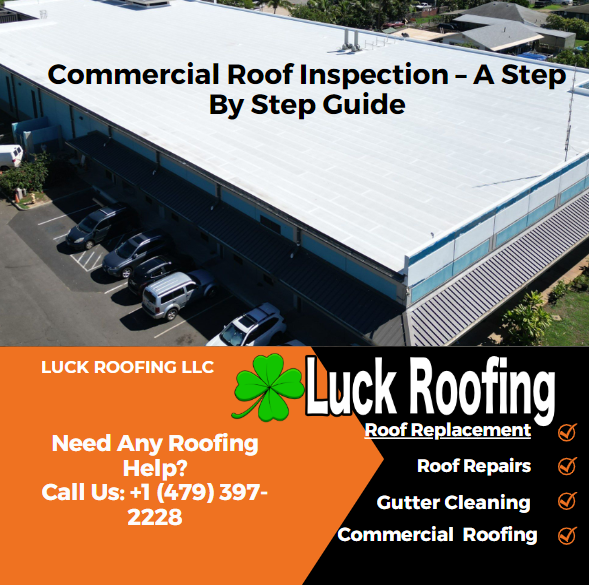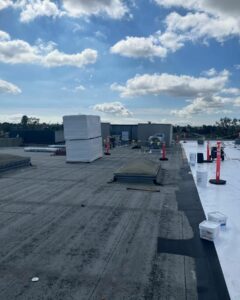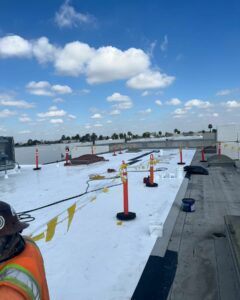The Cost of a Commercial Roof Inspection: An Overview

As we consider the multifaceted responsibilities of property management, the significance of commercial roof inspections cannot be understated. This crucial process evaluates the structural integrity of a building’s roof, shedding light on potential issues, from leaks to moisture build-up. Regular inspections not only safeguard the occupants within but also contribute to the longevity of the property and its overall value. While we understand the immediate benefits, the question remains: Are we truly maximizing the potential of these inspections, and what more can be gleaned from this essential practice?
Key Points To Takeaway
- Commercial roof inspections safeguard building occupants, prevent costly roof repairs to your building , and comply with insurance policies.
- Types of inspections include pre-roof, routine, emergency, and proactive, carried out by various professionals.
- The inspection involves a comprehensive visual examination of the roof, focusing on critical components using a commercial checklist for building roofs.
- Key components of the commercial roof inspection checklist include identifying water stains, assessing roof surface, and checking drainage systems and quoting on drainage installation cost where necessary.
Importance Of Commercial Roof Inspections
 Understanding the importance of commercial roof inspections is essential for property owners as it not only ensures the safety of the building’s occupants but also helps to prevent unexpected and costly repairs. A commercial roof inspection, conducted by a professional roofing contractor, involves an in-depth assessment of the roof’s condition both inside and out. This includes identifying potential leaks, evaluating moisture levels, and assessing the roof’s overall structural integrity.
Understanding the importance of commercial roof inspections is essential for property owners as it not only ensures the safety of the building’s occupants but also helps to prevent unexpected and costly repairs. A commercial roof inspection, conducted by a professional roofing contractor, involves an in-depth assessment of the roof’s condition both inside and out. This includes identifying potential leaks, evaluating moisture levels, and assessing the roof’s overall structural integrity.
Regular roof inspections are a proactive approach to roof maintenance, potentially saving property owners substantial amounts of money long term. The early detection of roof issues is beneficial in preventing costly repairs or even a complete roof replacement. Furthermore, by detecting and addressing these issues early, the lifespan of the roof is significantly extended, and the property’s value is maintained.
Moreover, commercial roof inspections are often required for compliance with insurance policies. Insurance companies typically require proof of regular roof inspections and maintenance to validate claims related to roof damage. Without this proof, property owners may find themselves facing denied claims and out-of-pocket expenses for repairs.
Lastly, conducting regular roof inspections provides property owners with peace of mind. Knowing that potential issues are being actively identified and addressed allows for a sense of security, not only for the property owner but also for the building’s occupants. In addition, regular inspections can lead to improved energy efficiency, adding another layer of financial benefit.
Types Of Commercial Roof Inspections
 With the significance of commercial roof inspections established, it’s pertinent to explore the varying types of inspections, each serving a specific function in maintaining the roof’s condition and performance.
With the significance of commercial roof inspections established, it’s pertinent to explore the varying types of inspections, each serving a specific function in maintaining the roof’s condition and performance.
The pre-roof inspection is the first type of commercial roof inspection. This assessment is conducted before construction or renovation activities begin to ensure compliance with design plans and specifications. It allows for the identification of any potential issues that could interfere with the roofing project, facilitating preemptive action.
Routine inspections are another crucial type of commercial roof inspections. These are scheduled at regular intervals, typically twice a year or after severe weather events. Routine inspections play a significant role in monitoring the roof’s condition over time, enabling the early detection and prompt addressing of any emerging issues. This proactive approach helps extend the roof system’s lifespan and prevents costly, extensive repairs in the future.
The third type of inspection is the emergency inspection. These are performed in response to unexpected events such as severe weather or structural damage. Emergency inspections are critical in assessing immediate risks, determining the extent of damage, and planning necessary repairs or replacements. They provide a rapid response to unforeseen incidents, thereby mitigating the impact on the roof system and the building.
Professionals Conducting Roof Inspections
A variety of professionals, including general contractors, manufacturers’ representatives, and third-party inspectors, play integral roles in conducting commercial roof inspections. These inspections are necessary to maintain the structural integrity and longevity of commercial roofs, ensuring they meet industry specifications and standards.
General contractors, typically the first professionals involved in a roof inspection, assess the roof’s compliance with construction standards. They are often the first line of defense against potential issues, capable of identifying structural weaknesses or damages.
Manufacturers’ representatives, on the other hand, validate warranty claims and evaluate the condition of commercial roofs. Their role is crucial in ensuring that roofing products perform as promised by the manufacturer. By conducting these inspections, they confirm the integrity of the material used and its installation process.
Third-party inspectors provide unbiased assessments, offering recommendations based on their findings. They are often employed for their impartiality, offering an objective evaluation of a commercial building’s roof condition.
At the heart of a successful roofing project lies the indispensable role of a professional commercial roofing contractor, with Luck Roofing standing out as the premier choice. Their unparalleled expertise and extensive experience empower them to conduct meticulous roof inspections, adeptly uncovering and diagnosing intricate roofing challenges. Luck Roofing excels in proposing tailored, economical solutions, ensuring that commercial building owners benefit from a comprehensive roof inspection that preemptively addresses potential concerns, averting significant future complications.
Differences: Commercial Vs. Residential Inspections
Commercial and residential roof inspections, though sharing a common goal of ensuring structural integrity and longevity, exhibit distinct differences in terms of complexity, size, equipment involved, and the level of professional intervention required. Commercial roof inspections typically necessitate professional inspectors due to the intricacy of the spaces, including the presence of various equipment installed on the roof. This additional equipment not only increases the complexity of the inspection but also the size of the roof area to be covered, leading to a more time-consuming and comprehensive process.
On the other hand, residential roof inspections are generally simpler and smaller in scale, allowing homeowners to conduct their periodic inspections. Despite this, professional inspectors can still offer a thorough and detailed assessment that may be overlooked by the untrained eye.
Both commercial and residential roof inspections are vital to maintaining the structural integrity of the building. However, the implications of overlooking potential issues differ. In commercial buildings, failure to identify and address issues early can lead to costly repairs, compromise safety standards, and impact the value of the property negatively. For residential properties, while the financial implications may be smaller, the safety and comfort of the home may be jeopardized.
The Roof Inspection Process Explained
 looking into the specifics of the roof inspection process, it involves a meticulous visual examination of the entire roof system, complemented by an in-depth inspection of critical components including shingles, fascia, soffit, drains, gutters, vents, and flashing. Professional roofing contractors conduct this comprehensive evaluation to identify any potential roof problems.
looking into the specifics of the roof inspection process, it involves a meticulous visual examination of the entire roof system, complemented by an in-depth inspection of critical components including shingles, fascia, soffit, drains, gutters, vents, and flashing. Professional roofing contractors conduct this comprehensive evaluation to identify any potential roof problems.
The inspection process begins with a visual check from the ground. Roofing contractors look for obvious signs of wear and tear, such as missing or damaged shingles, rusting or loose flashing, and organic growth like moss or algae. A more detailed inspection follows, with the contractors climbing onto the roof to examine the aforementioned critical components.
The purpose of these inspections is to detect potential roof problems before they escalate into costly repairs. This process is especially important in commercial roofing, where the scale and complexity of the roofing system can lead to significant issues if not maintained properly.
The commercial roof inspection process includes:
- Checking for signs of water damage or leaks, such as stains or mold
- Inspecting the soffit and fascia for deterioration or damage
- Examining the condition of the drains and gutters, looking for blockages or structural issues
- Assessing the state of vents and flashing to ensure they are intact and functioning properly
Checklist For Commercial Roof Inspection
To ensure a thorough and effective assessment of a commercial roof, inspectors use a detailed checklist that includes key components such as the roof deck, surface membranes, roof vents, metal flashing, and building gutters. This checklist is pivotal as it helps in the early detection of potential issues, saving building owners from costly repairs and maintaining the overall structural integrity of the building.
One of the main items on the checklist is the identification of water stains both in the interior and exterior parts of the roof. Water stains are often indicative of leaks, which can compromise the structural integrity of the roof. Another crucial item on the checklist is the collection and examination of core samples from different parts of the roof. These samples can reveal moisture levels, the presence of rot and other damage not visible to the naked eye.
The checklist also includes a comprehensive roof surface evaluation, which involves looking for signs of ponding water, cracks, blisters, and uplifted sections in the seams of membrane roofs. These are signs of aging and wear, which if not addressed promptly, could lead to more significant problems down the line.
Inspectors also pay special attention to the metal flashing around the roof’s perimeter, penetrations, and at the junction of the roof and vertical surfaces. Poorly installed or damaged flashing is a common cause of leaks. Lastly, the building’s gutters, drains, and downspouts are inspected to ensure that they are clean and functioning properly, preventing water accumulation on the roof. This comprehensive checklist provides a systematic approach to roof inspection, ensuring that all potential problem areas are assessed and addressed promptly.
Learn about commercial gutter installation cost for your building here
Preparing For A Commercial Roof Inspection
In preparing for a commercial roof inspection, it is essential to adopt a systematic approach to ensure all vital aspects are covered. This includes scheduling the inspection every six months, documenting existing issues, clearing the roof of debris, ensuring access to all roof areas, and providing relevant historical records. A well-prepared building owner can facilitate a smooth inspection process and help the roof inspector perform a comprehensive and reliable commercial roof examination.
To begin with, regular inspections should be scheduled every six months. This allows for early detection of potential issues and ensures the longevity of your commercial roof. Documenting existing problems is another essential step. This could include leaks, moisture problems, or visible damage. Providing this information to the roof inspector can guide their inspection and help in their assessment.
Moreover, it is important to clear the roof of debris. Accumulated debris can hide underlying issues and prevent a thorough inspection. Thus, a clean roof ensures all types of roof surfaces can be properly evaluated.
Next, ensure access to all roof areas. The more areas the roof inspector can access, the more thorough the inspection is likely to be. This includes access to roof equipment and penetrations.
Lastly, provide the roof inspector with historical records related to your roof. This could include previous inspection reports, repairs, and maintenance activities. This information can provide a context for the inspector and help them understand any recurring issues.
Dealing With Issues Found During Inspections
After the thorough process of a commercial roof inspection, it becomes imperative to address the issues uncovered, ensuring the roof’s structural integrity and longevity. One common problem identified during inspections includes damage to the roofing layers. This may manifest as cracks, bulges, or valleys that can compromise the structure and stability of the roof. To ensure the roof’s longevity, it is essential to repair these issues promptly.
Ponding water issues are another common discovery during inspections. This condition indicates inadequate drainage and can lead to water seepage, damaging the roofing layers and potentially causing leaks within the building. Addressing these issues promptly prevents further damage and potential roof deterioration.
Rust and corrosion, often detected during inspections, may signify moisture damage. Left untreated, this can weaken the roof’s structural integrity and shorten its lifespan. Therefore, immediate repair is necessary to mitigate the damage and extend the roof’s life.
Similarly, punctures and tears in the roof can let in water, leading to further roof damage and potential interior damage. These issues need urgent attention to prevent water intrusion and ensure the roof’s durability.
Benefits Of Regular Roof Inspections
While often overlooked, regular commercial roof inspections bring a multitude of benefits, paramount among them being the prevention of expensive repair costs through early problem detection. A thorough examination of your roofing system can identify minor concerns before they morph into major, cost-intensive issues. By choosing to walk the roof regularly, you actively extend the life of your commercial roof.
- Prevention of costly repairs: Regular inspections can spot potential problems early, averting the need for expensive repairs.
- Safety assurance: Inspections ensure the safety of the building’s occupants by identifying and solving issues that could compromise the roof’s structural integrity.
- Extended lifespan: Regular maintenance and timely repairs extend the life of your roofing system, thereby maximizing your investment.
- Protection against severe weather: Regular inspections can help prepare your roof for severe weather conditions, reducing potential damage.
By identifying issues early, you can take preventive measures to maintain the structural integrity of your roof. This not only assures the safety of the building’s occupants but also helps to sustain the overall value of your property.
In addition, regular roof inspections can lead to improved energy efficiency. This is achieved by ensuring the insulation is in good condition and that there are no leaks or drafts that could affect the building’s temperature regulation.
Contact us today to schedule a comprehensive commercial roof inspection. Our team of experts will ensure that your roof is in optimal condition, extending its lifespan, and saving you from potential expensive repairs down the line. A well-maintained roof is not just an investment but also a guarantee of peace of mind.
To Sum It All Up
To sum up, commercial roof inspections are crucial investments that safeguard property, extend roof lifespan, and enhance energy efficiency. Regular inspections by professionals ensure early detection of potential issues, facilitating timely and cost-effective solutions. These procedures, differing from residential inspections, involve meticulous scrutiny of the roof’s interior and exterior elements. Thus, understanding the process and preparing for it effectively can ensure maximum benefits from commercial roof inspections.
Michael Overzat
Michael Overzat resides in Fort Smith, Arkansas with his wife and three kids. He enjoys to hike, skateboard, write, and get involved in charity organizations. He was originally born in Maryland. He has worked within the roofing industry for 5 years and is very active within the industry by attending conferences, masterminds, etc. His vision is to create a multi-state organization that has a customer centric model. He's worked for some of the biggest names in the industry and hopes to create a more people focused model for the roof replacement process.
